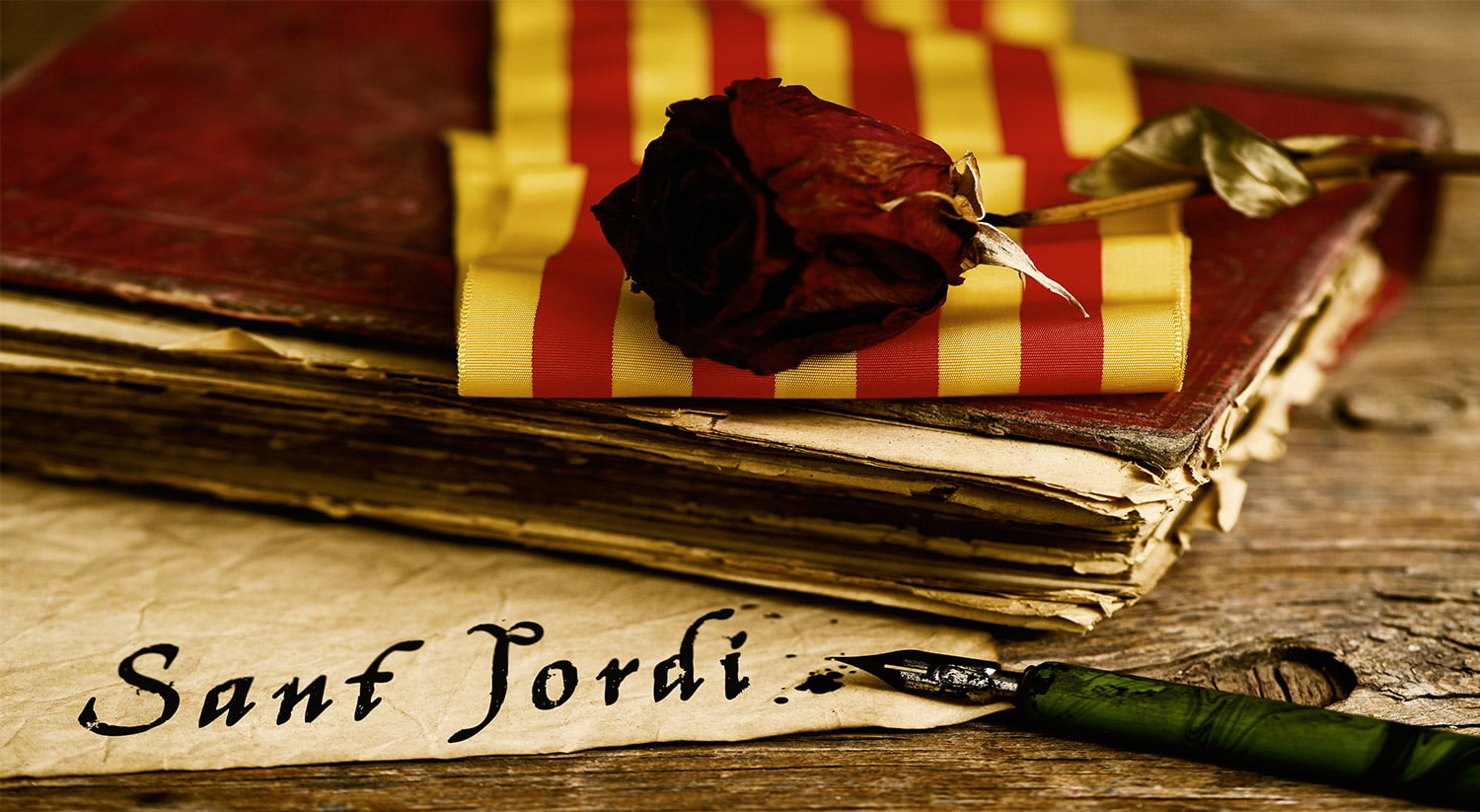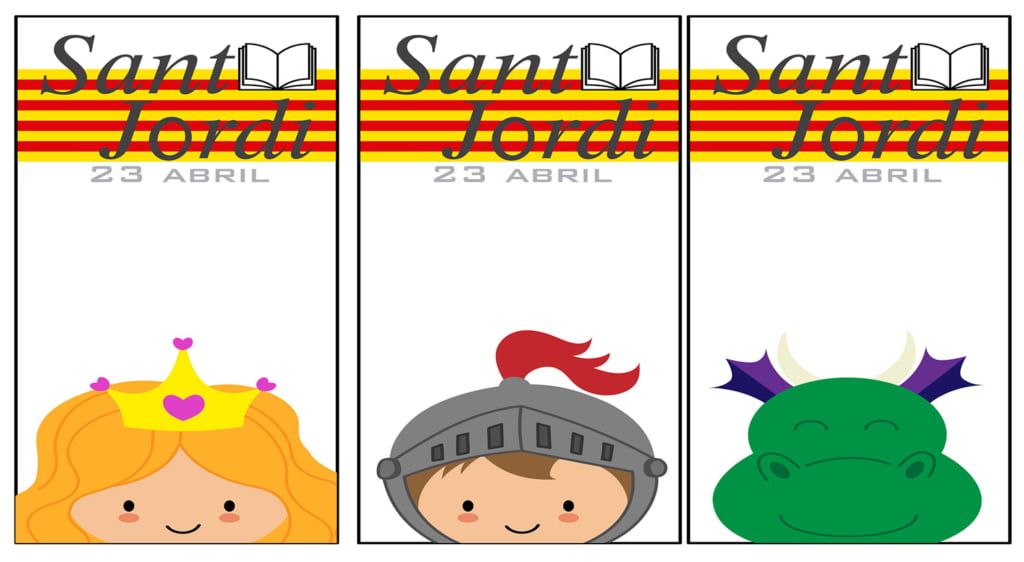
Sant Jordi, the patron saint of Catalonia, is celebrated on April 23rd, a day when culture and love intertwine through the exchange of books and roses, a tradition that dates back to the 15th century.
This date not only highlights the richness of Catalan culture, but has also become a symbol of the expression of love and literature. Places like “La Rambla de Barcelona” are transformed into lively meeting places for book and rose sellers.
It is a day when the Catalan language and heritage are actively promoted, making it an important celebration for both locals and those interested in exploring Catalan culture.
In this article, we will take you through the fascinating history of Sant Jordi, its cultural and social impact today, and how the tradition of giving roses and books has become a pillar of Catalan identity.
We will also explore how the celebration has spread beyond Catalonia and delve into Sant Jordi’s significant contribution to Catalan literature and culture.
Get ready to be immersed in a holiday that combines love, culture, and literature, giving you an intimate look at what makes Catalan culture truly unique and how you can be a part of this beautiful tradition.
The Legend of Sant Jordi
The legend of Sant Jordi tells the story of a brave knight who rescued a princess from a fearsome dragon and gave her a rose as a token of his love and bravery.
This story is not only central to the celebration of Sant Jordi in Catalonia, but has also given rise to the traditions of giving roses and books on this special day.

Origin and symbolism
The story takes place in Montblanc, where a dragon demanded daily sacrifices and even threatened the life of the local princess. At this critical moment, Sant Jordi appears, confronts the dragon and defeats it. From the blood of the defeated dragon grows a rose bush, from which Sant Jordi cuts a rose to give to the princess, symbolizing love and the triumph of good over evil.
This heroic act is not only a pillar of Catalan culture, but also represents the struggle between faith and paganism, and the protection of those who fight for just causes.
Derived traditions and their cultural impact
Inspired by this act of heroism and love, the gift of roses has continued to this day and is an essential part of the celebration of Sant Jordi. In addition, the tradition of giving books began in the 1920s, adding a cultural and educational element to the holiday.
Every year, the streets of Catalonia are filled with rose and book stalls, where people celebrate love, culture and literature, reaffirming their Catalan identity and promoting the region’s language and cultural heritage.
Sant Jordi in the present
Activities and festivities in the present
Sant Jordi has become a lively festival that is celebrated not only in Barcelona, but in many other parts of the world. The streets of Barcelona are filled with book and rose stalls, creating a festive and romantic atmosphere. In addition to the sale of books and roses, there are cultural activities such as poetry readings, author signings, dance performances and iconic locations decorated with roses.
During this day, you can enjoy traditional Catalan dances such as sardanes and “castells” in places like Plaça Sant Jaume, and many buildings such as City Hall, Palau Güell, the modernist complex of Sant Pau, the Ateneo and Palau de la Generalitat organize special activities or open their doors for free visits.
International influence and technological adaptation
The celebration of Sant Jordi has crossed borders and reached cities such as New York, Berlin, Tokyo, Singapore, Beijing, Mexico City and London, where the day is dedicated to world literature, with a focus on Catalan literature.
This demonstrates the international expansion of Catalan culture and how Sant Jordi has become a symbol of Catalan identity on a global scale. In addition, the future of the Sant Jordi festival may include an adaptation to technology, as the world becomes increasingly digital and the book industry is influenced by technology.
Contemporary tradition and symbolism
In Catalonia, the day of Sant Jordi is not an official holiday, but is traditionally celebrated with the exchange of roses and books between couples and loved ones, reflecting the legend of Sant Jordi. It is customary for men to give women a rose and women to give men a book, recalling the legendary act of Sant Jordi giving a rose to the princess.
The tradition of giving roses dates back to the 15th century, while the tradition of giving books began in 1926 and has become an important expression of culture and love in Catalonia.
Cultural and social impact
The Sant Jordi Festival not only celebrates culture and love through the tradition of exchanging books and roses, but also plays a crucial role in the cultural affirmation of Catalonia, especially during periods of cultural repression.
The festival has become international, taking the rich Catalan culture beyond its borders and demonstrating its ability to unite people around literature and cultural heritage.
Promotion of Catalan culture
The modernization of the festival, influenced by the Catalan movement of the 19th century, has strengthened its role as an event of cultural affirmation. In addition, its recognition by UNESCO as the World Book and Copyright Day underlines the global importance of this tradition.
Every year on April 23, it is celebrated not only in Catalonia, but also in cities all over the world, promoting the Catalan language and culture in a global context.
Initiatives and international expansion
The Diplocat Consortium has been working since 2015 to internationalize the Day of Books and Roses, using the hashtag #BooksAndRoses, which has helped spread the Catalan tradition around the world.
Turisme de Barcelona, for example, has taken cultural proposals to international fairs such as the Buenos Aires Book Fair, highlighting the literary wealth of Barcelona and Catalonia. This expansion not only celebrates literature and culture, but also strengthens the Catalan identity on the international scene.
Catalan literature and culture in Sant Jordi
The tradition of giving books during Sant Jordi has its roots in the twentieth century and was first proposed by Vicente Clavel in 1923 to promote reading and coincide with the commemorations of the deaths of Cervantes and Shakespeare. It was officially established as the Day of the Book in 1926 during the Barcelona World Fair and has since become a celebration of literature and culture.
In Catalonia, the Setmana del Llibre in Català and the “Saló Internacional del Còmic in Barcelona” are outstanding events that highlight the importance of books in Catalan culture. Not only do these events attract thousands of visitors, but they also demonstrate the worldwide interest in literature and storytelling, promoting literary translation and the dissemination of Catalan culture.
The exchange of roses and books reflects an old tradition dating back to the 15th century, in which men give roses to women and women give books to men. This custom symbolizes an exchange of culture and love, reaffirming the Catalan identity and its rich literary heritage every year on April 23rd.
Tradition of giving roses and books
The Festival of Sant Jordi has its roots in the 15th century, when a rose fair was held in Barcelona to commemorate Sant Jordi and the tradition of giving roses as gifts was born. This celebration, which is a tribute to love and culture, has consolidated the custom of exchanging books and roses over time, gaining popularity and becoming a symbol of cultural expression.
Since the 15th century, the tradition of giving roses began with the red rose as a symbol of passion and love. The most popular rose during these celebrations is the “Red Naomi“, known for its bright red color and exceptional beauty, which captures the essence of love and courage that Sant Jordi represented.
This exchange not only reinforces the Catalan cultural identity, but also promotes the region’s literature and cultural heritage, creating a unique link between tradition and the modern expression of love and culture in Catalonia.
The celebration outside Catalonia
In Aragon, the figure of Saint George, patron saint of the region, is celebrated with great enthusiasm every year on April 23, known as the Day of Aragon. This day is characterized by a series of activities that include the Aragon Awards, institutional events and a variety of cultural and musical performances, in addition to the sale of books. The cross of Saint George, a prominent element in the coat of arms of Aragon, symbolizes the historical and cultural importance of this saint in the region.
In the city of Cáceres, Saint George’s Day commemorates the reconquest of the city by the Muslims in 1229. Local festivities include the selection and burning of a dragon, contests such as the Golden Feathered Hen, and, as in Catalonia, the sale of books. These celebrations reflect how the figure of Saint George is intertwined with local historical events, strengthening regional identity and tradition.
Finally, in Santurce, an area whose name derives from San Jorge, the Fiestas de San Jorge have been celebrated since time immemorial. These festivities are a testimony to the deep cultural resonance of the saint in different parts of Spain, beyond Catalonia.
Conclusion & Reflection
In this journey through the tradition of Sant Jordi, we have shared with you the essence of a festival that combines love, culture and literature in a symbolism that transcends borders and is deeply rooted in the heart of Catalonia.
From the legend of a knight triumphing over a dragon to the present day, where books and roses are exchanged as symbols of love and respect, we have seen how this celebration strengthens Catalan identity and promotes literature and culture in both a local and international context.
In this context of cultural discovery, we must not forget that the adventure of learning and cultural exploration does not end here. The Festival of Sant Jordi is just one of the many doors that open to the richness of the world’s traditions and literatures.
We encourage you to continue to explore, read, and participate in this cultural exchange that enriches us all. And when you’re ready to immerse yourself in the wonders of the different cultures and languages our world has to offer, click here to begin your language and cultural journey with Talkao!
This can be the first step in a wonderful adventure that will lead you to discover incredible tools to overcome language barriers with ease.
FAQ
- What is the Festival of Sant Jordi in Catalonia? The festival of Sant Jordi, celebrated every year on April 23, commemorates the death of the knight Jordi. This saint, who served under the Emperor Diocletian, refused to carry out the order to persecute Christians, for which he was martyred and beheaded.
- What does Sant Jordi stand for today? Sant Jordi has become a symbol of identity and tradition in Catalonia, representing values such as courage, love and overcoming adversity. The festival is considered the Catalan equivalent of Valentine’s Day, as Sant Jordi is the patron saint of lovers in the region.
- What is the legend of Sant Jordi? The legend of Sant Jordi tells how the saint saved a princess by killing a dragon. From the blood of the dragon, a rose bush was born, which has led to Sant Jordi being considered the patron saint of lovers in Catalonia, similar to Valentine’s Day.
- What is the relationship between Sant Jordi and International Book Day? In 1923, Vicent Clavel, a Valencian writer, suggested that the celebration of Sant Jordi coincide with International Book Day. This date, April 23, is also the anniversary of the death of two great writers: Miguel de Cervantes and William Shakespeare.












Newsletter